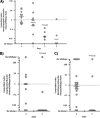Pneumococcal gene complex involved in resistance to extracellular oxidative stress
- PMID: 22215735
- PMCID: PMC3294666
- DOI: 10.1128/IAI.05563-11
Pneumococcal gene complex involved in resistance to extracellular oxidative stress
Abstract
Streptococcus pneumoniae is a gram-positive bacterium which is a member of the normal human nasopharyngeal flora but can also cause serious disease such as pneumonia, bacteremia, and meningitis. Throughout its life cycle, S. pneumoniae is exposed to significant oxidative stress derived from endogenously produced hydrogen peroxide (H(2)O(2)) and from the host through the oxidative burst. How S. pneumoniae, an aerotolerant anaerobic bacterium that lacks catalase, protects itself against hydrogen peroxide stress is still unclear. Bioinformatic analysis of its genome identified a hypothetical open reading frame belonging to the thiol-specific antioxidant (TlpA/TSA) family, located in an operon consisting of three open reading frames. For all four strains tested, deletion of the gene resulted in an approximately 10-fold reduction in survival when strains were exposed to external peroxide stress. However, no role for this gene in survival of internal superoxide stress was observed. Mutagenesis and complementation analysis demonstrated that all three genes are necessary and sufficient for protection against oxidative stress. Interestingly, in a competitive index mouse pneumonia model, deletion of the operon had no impact shortly after infection but was detrimental during the later stages of disease. Thus, we have identified a gene complex involved in the protection of S. pneumoniae against external oxidative stress, which plays an important role during invasive disease.
Figures








Similar articles
-
Streptococcus pneumoniae-Induced Oxidative Stress in Lung Epithelial Cells Depends on Pneumococcal Autolysis and Is Reversible by Resveratrol.J Infect Dis. 2015 Jun 1;211(11):1822-30. doi: 10.1093/infdis/jiu806. Epub 2014 Dec 15. J Infect Dis. 2015. PMID: 25512625
-
Thiol peroxidase is an important component of Streptococcus pneumoniae in oxygenated environments.Infect Immun. 2012 Dec;80(12):4333-43. doi: 10.1128/IAI.00126-12. Epub 2012 Oct 1. Infect Immun. 2012. PMID: 23027531 Free PMC article.
-
phgABC, a three-gene operon required for growth of Streptococcus pneumoniae in hyperosmotic medium and in vivo.Infect Immun. 2004 Aug;72(8):4579-88. doi: 10.1128/IAI.72.8.4579-4588.2004. Infect Immun. 2004. PMID: 15271918 Free PMC article.
-
Streptococcus pneumoniae and Its Virulence Factors H2O2 and Pneumolysin Are Potent Mediators of the Acute Chest Syndrome in Sickle Cell Disease.Toxins (Basel). 2021 Feb 17;13(2):157. doi: 10.3390/toxins13020157. Toxins (Basel). 2021. PMID: 33671422 Free PMC article. Review.
-
The oxidative stress response of Streptococcus pneumoniae: its contribution to both extracellular and intracellular survival.Front Microbiol. 2023 Sep 13;14:1269843. doi: 10.3389/fmicb.2023.1269843. eCollection 2023. Front Microbiol. 2023. PMID: 37789846 Free PMC article. Review.
Cited by
-
Lateral Acquisitions Repeatedly Remodel the Oxygen Detoxification Pathway in Diplomonads and Relatives.Genome Biol Evol. 2019 Sep 1;11(9):2542-2556. doi: 10.1093/gbe/evz188. Genome Biol Evol. 2019. PMID: 31504492 Free PMC article.
-
Subversion of host immune responses by otopathogens during otitis media.J Leukoc Biol. 2019 Oct;106(4):943-956. doi: 10.1002/JLB.4RU0119-003R. Epub 2019 May 10. J Leukoc Biol. 2019. PMID: 31075181 Free PMC article. Review.
-
Absence of tmRNA Has a Protective Effect against Fluoroquinolones in Streptococcus pneumoniae.Front Microbiol. 2017 Jan 10;7:2164. doi: 10.3389/fmicb.2016.02164. eCollection 2016. Front Microbiol. 2017. PMID: 28119681 Free PMC article.
-
Differences in antibiotic-induced oxidative stress responses between laboratory and clinical isolates of Streptococcus pneumoniae.Antimicrob Agents Chemother. 2015 Sep;59(9):5420-6. doi: 10.1128/AAC.00316-15. Epub 2015 Jun 22. Antimicrob Agents Chemother. 2015. PMID: 26100702 Free PMC article.
-
Within-host selection is limited by an effective population of Streptococcus pneumoniae during nasopharyngeal colonization.Infect Immun. 2013 Dec;81(12):4534-43. doi: 10.1128/IAI.00527-13. Epub 2013 Sep 30. Infect Immun. 2013. PMID: 24082074 Free PMC article.
References
-
- Barbuti G, Moschioni M, Fumarulo R, Censini S, Montemurro P. 2010. Streptococcus pneumoniae modulates the respiratory burst response in human neutrophils. FEMS Immunol. Med. Microbiol. 60:57–62 - PubMed
-
- Bogaert D, de Groot R, Hermans PW. 2004. Streptococcus pneumoniae colonisation: the key to pneumococcal disease. Lancet Infect. Dis. 4:144–154 - PubMed
Publication types
MeSH terms
Substances
Grants and funding
LinkOut - more resources
Full Text Sources
Molecular Biology Databases
Research Materials

